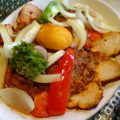Usually men like to show off - ah,trifles, by the way, - some beautiful, but completely useless story. And how are we worse, I thought. Besides, it is interesting what we eat. I did not think for long, but climbed to find out the biography of the first thing that came to me in the refrigerator. A packet of Japanese horseradish was waiting for its turn to be eaten - So, Wasabi. Japanese variety of horseradish Wasabia japonica (Cochlearia wasabi or Eutrema japonica, about the latter, however, some sources write that they are identified erroneously); belongs to the cruciferous family - that is, all cabbage-radishes and our native horseradish. The light green root is dried, ground and rubbed into a paste. This is how sushi seasoning is obtained. Or sushi? Well, that's not what we're talking about. Japanese horseradish is really horseradish from the mountain. Wasabi grows on the banks of mountain rivers. Cultivation of this herb began in the 10th century. There are two agricultural techniques: growing in cold mountain water in a semi-submerged state and in a vegetable garden. The second variety is considered to be of lower quality; frozen and wet wasabi is considered to have a special charm (or anger). There is not enough Japanese wasabi for everyone, so it is grown by the Taiwanese, Oregonians, Chinese and New Zealanders. Wasabia japonica, thanks to special substances - isothiocyanates - prevents tooth decay. Research has shown that these substances successfully suppress the growth of Streptococcus mutans - bacteria that cause caries. Thanks to the same isothiocyanates, wasabi can be used to fight cancerous tumors. In addition, this substance is known to prevent the formation of blood clots and act as an anti-asthmatic component. And the extreme popularity of the seasoning in combination with raw fish can be explained by the strong antimicrobial properties of wasabi. Very decorative burdocks - also wasabi:
Very decorative burdocks - also wasabi: Here, in a condensed form, etymology, chemicalcomposition and links for inquiring minds. There is an article on wasabi and in the Wiki (I repent, put my hand to it). The use of wasabi for food in the form of a grated root began in 1396 in the Shizuoka area. Residents of Shizuoka brought wasabi as a gift to the future shogun Neyasu Tokusava. Unfortunately, the history is silent about what kind of relations the residents had with the ruler before the gift, but after all it was not bad. Tokusave really liked this plant, he began to distribute wasabi in other regions of Japan. Stems and flowers wasabi, incidentally, are also used in Japanese cuisine. But let's go back to the refrigerator. What wasabi gets to our tables? In addition to the present HONVASABI, tablets are widely used. It's not real Japanese fuck. All these surrogates (let's call things by their proper names) and imitations are prepared from a vegetable called wasabi-daikon. They say that it was brought to Japan relatively recently from somewhere in Europe. Now, the wasabi-daikon is grown, mainly, in Hokkaido. In Europe, this type of horseradish is used as a seasoning for roast beef. Honvasabi and wasabi-daikon are different plants. However, their sharpness and taste are almost identical. Nevertheless, in high-class Japanese restaurants chefs do not use wasabi-daikon, considering it a fake for wasabi. Wasabi-daikon is much cheaper than honvasabi, so it's much easier to buy it. The wasabi-daikon is white, so a green dye is added to it to look like honvasabi. In tubes with wasabi-daikon, mustard is often added in order to give a special sharpness and make the paste softer. Here is a story from the refrigerator. And now I'll go to the store, suddenly, is there something more delicious to inspire?
Here, in a condensed form, etymology, chemicalcomposition and links for inquiring minds. There is an article on wasabi and in the Wiki (I repent, put my hand to it). The use of wasabi for food in the form of a grated root began in 1396 in the Shizuoka area. Residents of Shizuoka brought wasabi as a gift to the future shogun Neyasu Tokusava. Unfortunately, the history is silent about what kind of relations the residents had with the ruler before the gift, but after all it was not bad. Tokusave really liked this plant, he began to distribute wasabi in other regions of Japan. Stems and flowers wasabi, incidentally, are also used in Japanese cuisine. But let's go back to the refrigerator. What wasabi gets to our tables? In addition to the present HONVASABI, tablets are widely used. It's not real Japanese fuck. All these surrogates (let's call things by their proper names) and imitations are prepared from a vegetable called wasabi-daikon. They say that it was brought to Japan relatively recently from somewhere in Europe. Now, the wasabi-daikon is grown, mainly, in Hokkaido. In Europe, this type of horseradish is used as a seasoning for roast beef. Honvasabi and wasabi-daikon are different plants. However, their sharpness and taste are almost identical. Nevertheless, in high-class Japanese restaurants chefs do not use wasabi-daikon, considering it a fake for wasabi. Wasabi-daikon is much cheaper than honvasabi, so it's much easier to buy it. The wasabi-daikon is white, so a green dye is added to it to look like honvasabi. In tubes with wasabi-daikon, mustard is often added in order to give a special sharpness and make the paste softer. Here is a story from the refrigerator. And now I'll go to the store, suddenly, is there something more delicious to inspire?

Making Money with Desserts: Success Stories
Evgeniya Polischuk (Fedutinova) instagram:@evgeniyafedutinovavk.com/janeshomebaking– It all started with baking for family and friends. Gradually, I started posting photos of my baked goods on Instagram – and orders started coming in. I made my first custom-made cake on October 13, 2014, and a little earlier I started making macaroons and cupcakes. You could say that the business “found me”, I am very […]

Soups are cold recipes with photos
Cold cucumber soup with yogurt and lemonsorbet from the chef of the restaurant La Taverna Alexander Zhurkin Photo: Getty Images Ingredients: Plain yoghurt – 125 g Cucumber – 150 g Lemon/lime sorbet – 50 g Cocktail shrimp – 24 g Fresh ginger juice – 1 g Lime juice – 5 g Fresh orange juice – 5 g Parsley – 1 g Pink pepper – 1 g Watercress – […]

barbeque kebab
Pork tenderloin in glaze Photo:Dmitry Bayrak/dbstudioPreparation time: 20 minutes + marinating time.Calories: 454 kcal per serving.For 4 servings: 4 pork tenderloins (approximately 300 g each), 1 onion, 2 cloves of garlic, 1 tsp. lemon zest, 1 tsp. lemon juice, a pinch of ground cumin, coriander and turmeric, 1 tbsp. vegetable […]

Pierre Duacan: dietary recipes: Ducane diet
Beetroot soup Photo:Season’S, Luxury Hotels RepresentationYou will need:· Boiled beetroot – 60 g· Fresh cucumbers – 20 g· Red radish – 20 g· Green onions – 10 g· Egg – 1 pc.· Drinking mineral water – 200 g· Salt – 1 gPreparation:· Boil the egg and beetroot.· Grate the cucumbers, radish and part of the beetroot. Put everything […]





